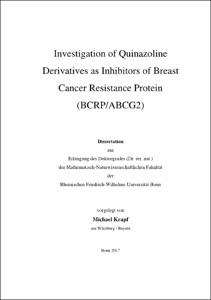Investigation of Quinazoline Derivatives as Inhibitors of Breast Cancer Resistance Protein (BCRP/ABCG2)

Investigation of Quinazoline Derivatives as Inhibitors of Breast Cancer Resistance Protein (BCRP/ABCG2)

| dc.contributor.advisor | Wiese, Michael | |
| dc.contributor.author | Krapf, Michael | |
| dc.date.accessioned | 2020-04-25T00:14:06Z | |
| dc.date.available | 2020-04-25T00:14:06Z | |
| dc.date.issued | 12.03.2018 | |
| dc.identifier.uri | https://hdl.handle.net/20.500.11811/7515 | |
| dc.description.abstract | The treatment of cancer with chemotherapeutic drugs is strongly limited by intrinsic or aquired resistance of the cancer cells. This is the main reason of a failure of the therapy. The cellular resistance mostly originates from an overexpression of ABC transport proteins that efflux many structurally diverse molecules, including several chemotherapeutic drugs, out of the cells. Due to the reduced concentration of cytostatic drugs in the resistant cancer cells higher doses of the cytostatic agent are required, leading to systemic toxic effects, and may render the therapy ineffective. A possible way to overcome this so-called multidrug resistance (MDR) is to target the efflux transport proteins with suitable inhibitors. In this study several inhibitors of ABCG2 - one of three major ABC transport proteins that are associated with MDR - were synthesized. To date, only few potent, selective and nontoxic inhibitors have been discovered for ABCG2. For this reason a library of 219 novel compounds based on a quinazoline scaffold or closely related structures was developed and investigated in several functional assays. The investigations comprise the determination of the inhibitory potency and selectivity toward ABCG2 as well as the cytotoxicity of the compounds. Further studies aimed to explore the ability of a compound to reverse the MDR toward common cytostatic drugs such as SN-38 and mitoxantrone (MX). Other studies were used to help shed some light on the function of the protein. Thus, enzyme kinetic investigations of several compounds were carried out in the presence of the substrate Hoechst 33342 to gain insights into the different binding modes of the inhibitors. Complementary to that, a conformation sensitive 5D3 antibody binding assay was conducted to find patterns among the inhibitors to provide a meaningful classification. The investigation of the ATPase activity obtained some information related to the transport activity of the protein in co-administration of inhibitors. Overall, this work yielded 40 highly potent inhibitors of ABCG2, with IC50 values below 100 nM in the Hoechst 33342 acumulation assay. For comparison, Ko143, which is considered as one of the most potent inhibitors of ABCG2 in literature, possessed an IC50 value of 227 nM. Important molecular features that are vital for the activity of the corresponding quinazoline derivatives could be deduced via a SAR analysis. Moreover, the crucial factors regarding the selectivity of a compound could be determined, which can be beneficial for the specific synthesis of either selective or broadspectrum inhibitors. Also, the cytotoxicity of the quinazoline derivatives could be modulated, either by modification of the scaffold or specific substitution patterns, leading to several nontoxic compounds. The multidrug resistance toward commercial chemotherapeutic drugs was successfully reversed and the potency of the reversal could thereby be determined. Additionally, strong evidence for the existance of several binding sites in ABCG2 and possibly different modes of interaction of the inhibitors with the protein was provided by the different results in the investigation of the interaction type with Hoechst 33342, 5D3 shift, and ATPase assays. The collected data could contribute to the synthesis of further potent inhibitors with the desired characteristics and lead to a better understanding of the function of ABCG2. Owing to the excellent properties of some of the synthesized compounds the transfer of the in vitro experiments to in vivo studies is a promising prospect for continuative studies. | en |
| dc.language.iso | eng | |
| dc.rights | In Copyright | |
| dc.rights.uri | http://rightsstatements.org/vocab/InC/1.0/ | |
| dc.subject | Chinazolin | |
| dc.subject | Inhibitor | |
| dc.subject | BCRP | |
| dc.subject | ABCG2 | |
| dc.subject | Chemotherapie | |
| dc.subject | MDR | |
| dc.subject | zellbasierte Assays | |
| dc.subject | quinazoline | |
| dc.subject | multidrug-resistance | |
| dc.subject | cellular assays | |
| dc.subject | chemotherapy | |
| dc.subject.ddc | 540 Chemie | |
| dc.subject.ddc | 615 Pharmakologie, Therapeutik | |
| dc.title | Investigation of Quinazoline Derivatives as Inhibitors of Breast Cancer Resistance Protein (BCRP/ABCG2) | |
| dc.type | Dissertation oder Habilitation | |
| dc.publisher.name | Universitäts- und Landesbibliothek Bonn | |
| dc.publisher.location | Bonn | |
| dc.rights.accessRights | openAccess | |
| dc.identifier.urn | https://nbn-resolving.org/urn:nbn:de:hbz:5n-50017 | |
| ulbbn.pubtype | Erstveröffentlichung | |
| ulbbnediss.affiliation.name | Rheinische Friedrich-Wilhelms-Universität Bonn | |
| ulbbnediss.affiliation.location | Bonn | |
| ulbbnediss.thesis.level | Dissertation | |
| ulbbnediss.dissID | 5001 | |
| ulbbnediss.date.accepted | 19.12.2017 | |
| ulbbnediss.institute | Mathematisch-Naturwissenschaftliche Fakultät : Fachgruppe Pharmazie / Pharmazeutisches Institut | |
| ulbbnediss.fakultaet | Mathematisch-Naturwissenschaftliche Fakultät | |
| dc.contributor.coReferee | Müller, Christa E. |
Dateien zu dieser Ressource
Das Dokument erscheint in:
-
E-Dissertationen (4445)




